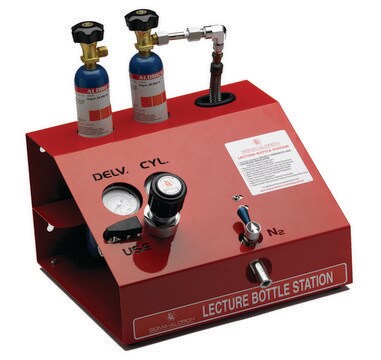Kluczowe dokumenty
About This Item
Polecane produkty
gęstość pary
0.97 (vs air)
Poziom jakości
ciśnienie pary
35.04 atm ( 20 °C)
Próba
99.99%
temp. samozapłonu
842 °F
granice wybuchowości
36 %
bp
−104 °C (lit.)
mp
−169 °C (lit.)
ciąg SMILES
C=C
InChI
1S/C2H4/c1-2/h1-2H2
Klucz InChI
VGGSQFUCUMXWEO-UHFFFAOYSA-N
Szukasz podobnych produktów? Odwiedź Przewodnik dotyczący porównywania produktów
Opis ogólny
Zastosowanie
Opakowanie
Compatible with the following:
- Aldrich® lecture-bottle station systems
- Aldrich® lecture-bottle gas regulators
Inne uwagi
Informacje prawne
króciec do węża
najczęściej kupowane z tym produktem
polecane
regulator
zawór kontrolny
zawór wylotowy
Hasło ostrzegawcze
Danger
Zwroty wskazujące rodzaj zagrożenia
Zwroty wskazujące środki ostrożności
Klasyfikacja zagrożeń
Flam. Gas 1 - Press. Gas Liquefied gas - STOT SE 3
Organy docelowe
Respiratory system
Kod klasy składowania
2A - Gases
Klasa zagrożenia wodnego (WGK)
nwg
Temperatura zapłonu (°F)
-148.0 °F - closed cup
Temperatura zapłonu (°C)
-100 °C - closed cup
Środki ochrony indywidualnej
Eyeshields, Faceshields, Gloves, multi-purpose combination respirator cartridge (US)
Wybierz jedną z najnowszych wersji:
Masz już ten produkt?
Dokumenty związane z niedawno zakupionymi produktami zostały zamieszczone w Bibliotece dokumentów.
Produkty
Reakcja Dielsa-Aldera jest reakcją pomiędzy sprzężonym dienem i alkenem (dienem) w celu utworzenia nienasyconych pierścieni sześcioczłonowych. Jest ona również określana jako cykloaddycja.
The Diels–Alder reaction is the reaction between a conjugated diene and an alkene (dienophile) to form unsaturated six-membered rings. It is also referred to as a cycloaddition.
Global Trade Item Number
| SKU | GTIN |
|---|---|
| 536164-110G | 4061833021644 |
Nasz zespół naukowców ma doświadczenie we wszystkich obszarach badań, w tym w naukach przyrodniczych, materiałoznawstwie, syntezie chemicznej, chromatografii, analityce i wielu innych dziedzinach.
Skontaktuj się z zespołem ds. pomocy technicznej










